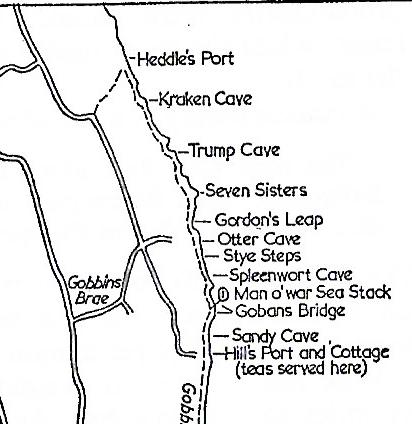
The Gobbins Cliff Path is open again for the 2019 season and hoping to build on last year’s visitor numbers of 30,000.
The guided tours take visitors along an amazing route beside the North Channel, sometimes a metre from the sea, other times much higher.
And one of the locations they pass, at the very end of the path, is Gordon’s Leap. The question is, however, who was Gordon?
Local wisdom has it that the area – which became home a suspension bridge linking one part of the path to another – was named after a local councillor who signed off on the proposal for the path.
Another is that during the massacre of Roman Catholic families in 1642, brought about as a consequence of a massacre of Protestants further north in the county a short time before, a man named Gordon was dragged off the cliff there by one of the victims. This story seems to have little foundation. The massacre, which was a nasty, horrible event in itself, did not occur at the Gobbins but at Carnspindal, now known as Millbay, further to the north west on the island.
There is a councillor named Gordon, however. John F. Gordon was a prominent labour representative within the Unionist Party in the 1920s. And he clearly had connection with Islandmagee: an old poster of a swimming gala at the Cove near the Gobbins in August 1920 has him listed as handicapper at the event.

There are Gordon families in north Islandmagee and the name appears in 1669 as Goardon on the island, when the family paid a hearth tax to the government. In the 1830s 25 year-old David Gordon was listed in the Ordnance Survey Memoirs – a sort of Irish Doomsday book – as migrating annually to Glasgow for work. We know that he was a labourer and a member of the Established Church.
And among the schoolteachers in Islandmagee in the past were James Trail Gordon, who lived at Bernabeg.
In 1911 there is a Gordon family at Temple Effin, which is close to the town of Whitehead, the head of the family being a Robert, who is 46. There are nine family members, one of them John, who is 6 years old and seems a little young to be the Cllr. J. F. Gordon mentioned in 1920. These Gordons were Presbyterians.
However there is clearly a Gordon connection with Islandmagee and John F. Gordon may well be part of it.
He is well documented in Northern Ireland history. He was son of William James Gordon and Margaret Fawcett and was sent to live with relatives in the United States after his father died. He returned from Falls River, Massachusetts and was a member of Belfast Corporation from 1920 to 1923. He represented Antrim and then Carrickfergus in the Northern Ireland Parliament from the formation of the state in 1921 until 1943. Partner in the firm of Fryar and Gordon Solicitors of Bridge Street in Belfast, John F Gordon served as Minister of Labour in Northern Ireland from 1938 to 1943. He resigned as MP for Carrick to take up a post as chairman of the National Assistance Board of Northern Ireland.
Gordon was a strong support of more left-wing politics, and was a strong supporter of the Ulster Unionist Labour Association, formed within the Unionist Party at the insistence of Sir Edward Carson to ensure that the voice of the working class was heard – and did not drift off to Independents or the Northern Ireland Labour Party at elections. In 1950 he was one of the Vice Presidents of the UULA.
John F. Gordon died at the age of 87 in June 1965 at his home, Innisfoyle Park, Belfast.
So was he the man after whom Gordon’s Leap was named. It is tempting to think so, not least on account of his high profile in the area as a politician.
But there are problems too.

The Gobbins Path was opened by the Belfast and Northern Counties Railway Company in 1902. John F. Gordon was 24 years old. Had the council on which Gordon sat any say on the path at that time? It was a private enterprise by the railway company and it is unlikely that councils had grant powers to assist.
The area across is too wide for anyone – not even a high ranking Belfast politician – to leap across, so was the ‘leap’ more symbolic: a leap of faith in some way, perhaps? Prior to the suspension bridge across Gordon’s Leap, the path stopped on the south side of the cave that dominates the landscape at that point. Berkeley Dean Wise, the genius who proposed the further extension was intent on going much further along the face of the cliffs, so was there a ‘leap of faith’ in some manner by someone called Gordon.
Or was John F. Gordon, who was clearly a familiar visitor to regettas on the island, the type of person to take a leap into the waters at the mouth of the first of the Seven Sisters caves?
To add to matters, the name Gordon may not even be a surname. Maybe someone working for the railway company has the given name Gordon and maybe he had something to say or do about the location of the suspension bridge.
One thing is clear. No one seems to know the full story, so a little bit of mystery remains, adding to the drama that is the Gobbins Cliff Walk.

I think that is my family. They were from Millbay.
LikeLike